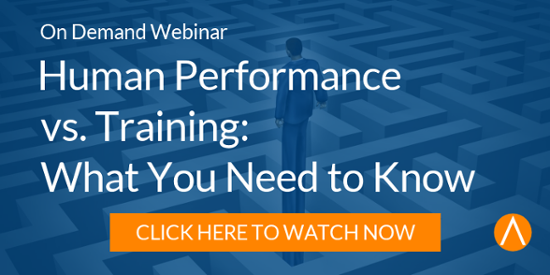Posted by Caveo Learning ● July 13, 2017
CUNY Learning Leader on Business Skills, Keys to Successful L&D
This is part of our ongoing series, Interviews with Learning Leaders.
 L. Patrick Dail is the director of workplace learning with the School of Professional Studies at the City University of New York. Dail manages teams charged with designing, developing, and facilitating learning and development programs for New York City agencies on topics ranging from emergency preparedness and business continuity to energy efficiency and child welfare. A Certified Professional in Learning & Performance (CPLP), he's spent 15 years in training and professional development roles within higher education, and is a former president of the New York City Chapter of the Association for Talent Development. He holds an MBA from the University of Phoenix and a bachelor's in European history from McDaniel College in Maryland, and is pursuing a doctorate at Columbia University. His career focus at the moment is based on neuroscience—how adults make meaning of new information and translate that into practical wisdom, in order to better understand how to structure adult learning interventions to effect behavior change in workflow.
L. Patrick Dail is the director of workplace learning with the School of Professional Studies at the City University of New York. Dail manages teams charged with designing, developing, and facilitating learning and development programs for New York City agencies on topics ranging from emergency preparedness and business continuity to energy efficiency and child welfare. A Certified Professional in Learning & Performance (CPLP), he's spent 15 years in training and professional development roles within higher education, and is a former president of the New York City Chapter of the Association for Talent Development. He holds an MBA from the University of Phoenix and a bachelor's in European history from McDaniel College in Maryland, and is pursuing a doctorate at Columbia University. His career focus at the moment is based on neuroscience—how adults make meaning of new information and translate that into practical wisdom, in order to better understand how to structure adult learning interventions to effect behavior change in workflow.
What business skills do you find yourself using in your work as a learning professional?
Budget-building and management skills, and communications plan strategizing, are the two pieces that come to mind. I learned early in my L&D career the importance of building an effective budget when pitching a new initiative, making sure you have identified all the resources needed, and if possible, add in a 10% safety net. Then, as early into the process as possible, figure out who needs to know what, and when. Every time we gather feedback from our team members or the employee audiences we serve, a common piece of feedback we hear is, "I didn't know that was happening, would have been nice..." Sharing high-level details is critical to keeping employees motivated.
What are the hallmarks of a successful learning program, in your estimation?
 Employee and supervisor engagement are both critical to achieving change back in the workflow. We’re constantly focused on enhancing the learning culture in the organizations we partner with, and the smile sheets are an important indicator that the employees are engaged and prepared to change their practice. Moreover, a positive learning experience will motivate them to effectively participate the next time a mandatory or elective training is offered. Similarly, the supervisors are your key to making sure the new method is monitored and supported to achieve the desired performance over time.
Employee and supervisor engagement are both critical to achieving change back in the workflow. We’re constantly focused on enhancing the learning culture in the organizations we partner with, and the smile sheets are an important indicator that the employees are engaged and prepared to change their practice. Moreover, a positive learning experience will motivate them to effectively participate the next time a mandatory or elective training is offered. Similarly, the supervisors are your key to making sure the new method is monitored and supported to achieve the desired performance over time.
What is the value of L&D industry organizations like ATD?
The networking opportunities our local chapter has afforded me have been a key to my success. I can get too comfortable with our approach to designing initiatives, managing our established processes, etc. It can create a significant blind spot to innovation. But through networking with L&D colleagues, I learn alternative approaches to the work, and I hear about clever tools or techniques peers are having success with. It keeps us on top of our game.
Which technological advances of the past decade have provided the most positive change for L&D?
I understand some organizations are making significant progress with machine learning applications, and that there is tremendous potential here for all of us... but we're not all there yet. The integration of social media applications to extend the value of the core LMS seems to be an advancement that has had wider impact for the typical organization. I've seen clever new initiatives go down in flames because we tried to launch a new platform to support communities of practice, for example. But getting over that hurdle of asking the employee to embrace yet another technology platform can be a critical challenge.
In your experience, how do work habits and motivations of Millennials differ from older generations of workers?
Traditionalists, such as myself, are more apt to maximize internal knowledge management resources and navigate relationships within the organization. In a complementary way, Millennials, from my experience, are apt to look externally for ideas, such as mining blog posts for best practices or clever approaches to situations.
When you’re adding to your L&D team, what traits do you especially look for?
Innovation in the L&D space is important to me, so I like to discuss their experience in incorporating various techniques or tools into learning programs, and the success they've seen with them. However, ultimately it all comes down to fit, so we prepare a lot of culture and practice-related questions to gauge potential success on the team.
What’s the most important lesson you’ve learned in your time as an L&D professional?
Understand everything relevant about the target audience. Whether the initiative will impact a group of 15 or 1,500, you need to partner with the management team to be clear on what they believe is not happening, or what needs to be done differently. But your very next step is to start diving in to figure out what’s challenging the employee, the reason behind the performance problem(s), and the mental model shift that needs to happen.
What’s the best piece of professional advice you’ve received?
“Get to know the secretaries and the janitors, because they know how to make things happen.” My father told me that shortly after I walked across the stage with my BA in hand, and while we don’t have very many administrative assistants in the workplace any longer, we do have janitors. If you are responsible for facilitating a successful ILT training, at some point you’re going to be responsible for getting buildings unlocked, rooms set up, and technology working, which is why I still invest a lot of effort in getting to know the janitors.
Topics: Interviews with Learning Leaders

